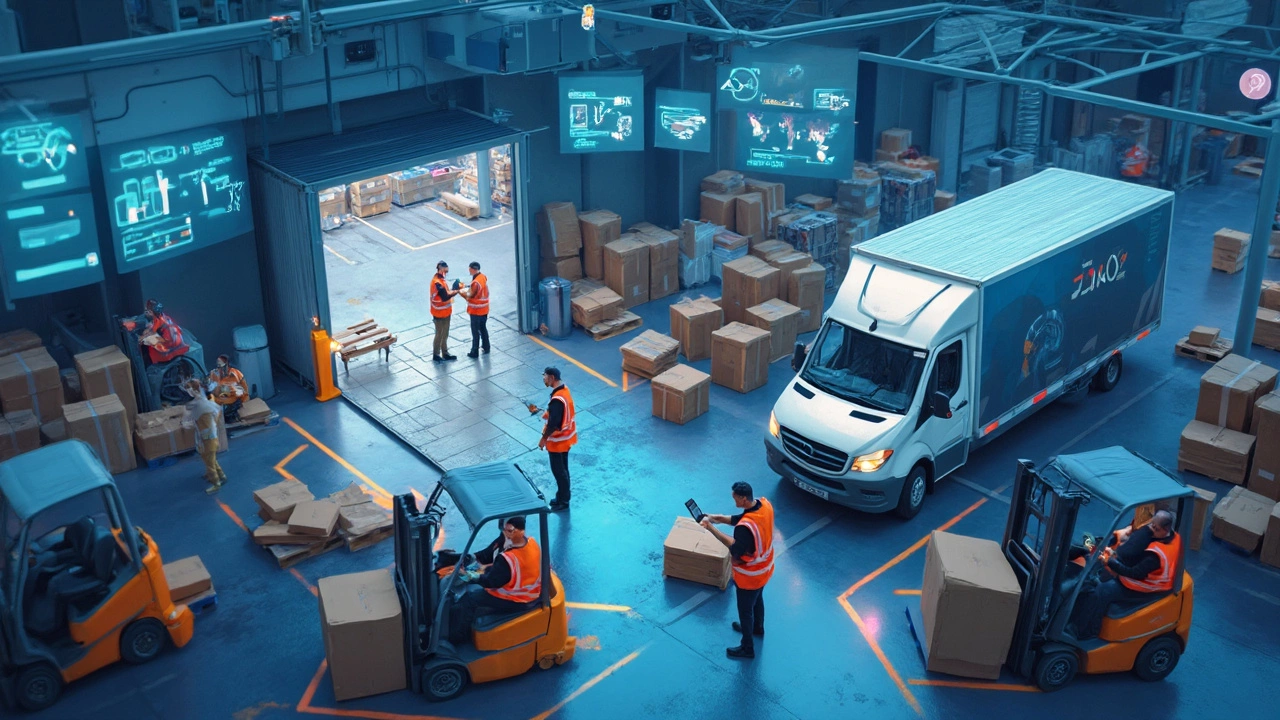Logistics Management System: The Backbone of Modern Supply Chains

Ever wonder how your late-night online impulse buys show up at your door just days later? Behind the scenes, it’s not magic—it’s a logistics management system running the show. Picture a control tower, but instead of planes, it's coordinating trucks, warehouses, and deliveries. These systems track every box, bottle, and pallet hopping from factory to doorstep.
At the core, a logistics management system helps businesses keep tabs on inventory, plan routes, handle shipments, and make sure nothing is lost or delayed. You need it to avoid mix-ups, wasted time, and angry customers. Even small shops with weekend rushes rely on this tech, not just shipping giants or global brands.
- What Does a Logistics Management System Really Do?
- Why Businesses Can’t Live Without Logistics Software
- Real-World Examples and Common Features
- How to Pick the Right Logistics Management System
- Game-Changing Tips for Getting the Most Out of Your System
What Does a Logistics Management System Really Do?
A logistics management system is like the brain of any delivery, shipping, or warehousing operation. Its job? Make sure everything moves smoothly, from raw materials entering the building to finished products landing in a customer's hands.
Let’s break it down. These systems connect the dots between buying, storing, picking, packing, shipping, and returns. Every scanned barcode, shipment update, or out-of-stock alert travels through the system. No more guesswork or whiteboards packed with scribbles.
- Inventory Control: Tracks what’s coming in, what’s going out, and what’s sitting on the shelf so you never run out or overstock.
- Order Management: Handles everything from order creation to final delivery, making sure nothing falls through the cracks.
- Shipping & Routing: Suggests the best carriers and routes, helping save cash on fuel and keeping customers happy with fast deliveries.
- Warehouse Operations: Manages picking, packing, and movement inside warehouses. Some even use robots powered by the system to grab goods.
- Returns: Deals with items sent back by customers, logging them in, handling refunds, or getting them ready to resell.
Check out the real impact of a good system:
| Function | Typical Time Saved | Common Error Rate Drop |
|---|---|---|
| Order Processing | Up to 60% faster | Errors fall by up to 90% |
| Inventory Counts | Real-time updates | Stockouts cut by 30% |
| Route Planning | Routes optimized instantly | Fuel costs slashed 10-20% |
One cool fact: modern logistics systems process millions of orders per day for companies like Amazon. Even small businesses can tap into similar software—no need to handle things on paper anymore. Think of it as swapping out your old flip phone for a smartphone. Once you try it, there’s no going back.
Why Businesses Can’t Live Without Logistics Software
Picture this: You’re running a company, big or small, and you start missing orders or mixing up shipments. Customers get annoyed, and money basically flies out the window. That’s where a logistics management system steps in. It keeps chaos out and makes sure you’re not stuck solving delivery disasters every single day.
Real talk—shipping, tracking, and warehousing are a nightmare without the right software. If you’re doing things manually or with basic spreadsheets, you already know how quickly things get out of hand. According to Gartner, 79% of businesses using modern logistics software report faster order processing and fewer mistakes. That means happier customers, more repeat business, and a reputation you can actually count on.
Here’s why ditching logistics software just isn’t an option anymore:
- Saves Time: Orders are tracked in real time, so you’re not scrambling for updates or lost packages.
- Cuts Costs: Smart route planning and inventory tracking shrink wasted fuel, dead stock, and overtime pay.
- Boosts Customer Satisfaction: People hate waiting. Automated alerts and accurate ETAs make them way more forgiving if something goes wrong.
- Keeps You Competitive: Your rivals are probably already on board. Falling behind here means losing business to faster, smoother operators.
Honestly, even small businesses can’t wing it like they used to. With e-commerce booming, consumer patience shrinking, and shipping prices rising, businesses need every edge. Logistics software is that edge.

Real-World Examples and Common Features
You probably hear about big names like Amazon or FedEx blazing through millions of orders a day. What’s the secret sauce? These giants rely on a logistics management system to handle the madness. Take Amazon, for example: their platform keeps track of everything from warehouse stock levels to which delivery driver should grab your package next. In fact, a single Amazon fulfillment center can handle up to 1 million packages a day, all thanks to their tight logistics tech.
But it isn’t just the big players. Even food distributors, car makers, and local shops need these systems. For example, a small online retailer might use popular software like ShipBob, Easyship, or even Shopify’s built-in logistics tools to automate shipping, track returns, or avoid selling items they don’t have in stock.
So, what features do most logistics management systems share? Here’s what you’ll find in almost every decent option:
- Order Tracking: From the second an order comes in to the final delivery, nothing should fall through the cracks.
- Inventory Management: Know exactly what’s on your shelf, what’s running low, and what’s coming in soon.
- Route Optimization: Systems like Route4Me can save delivery drivers hours by planning smarter routes, cutting fuel costs by up to 20%.
- Freight Management: Keep track of shipments coming by land, sea, or air—all in one dashboard.
- Analytics and Reporting: Spot trends, fix bottlenecks, and make smarter decisions with easy-to-read dashboards.
It’s not just about bells and whistles. These features can impact your bottom line. Check out this snapshot from a recent survey on logistics in 2024:
| Feature | % of Companies Using |
|---|---|
| Order Tracking | 95% |
| Inventory Management | 88% |
| Route Optimization | 73% |
| Freight Management | 68% |
| Analytics Tools | 81% |
Bottom line: whether you’re running a national delivery fleet or a small e-commerce shop, these systems make life way less chaotic. They bring all the moving parts—from inventory to last-mile delivery—under one digital roof.
How to Pick the Right Logistics Management System
Choosing the right logistics management system can feel like standing in front of a wall of shoes—lots look similar, but only a few will fit your business and make your life easier. It’s easy to get lost in sales pitches and slick demos, so here’s how to cut through the noise.
First, nail down what you really need. Does your business move hundreds of small orders every day, or a handful of bulk shipments each week? If you’ve got multiple warehouses or your stuff crosses borders, you’ll need tools that handle that complexity. For most companies, the must-haves are:
- Automatic order tracking (no more endless email chains)
- Inventory management (know what’s on hand, always)
- Route planning or delivery scheduling
- Easy integration with your existing sales and accounting systems
- Good customer support—you’ll thank yourself later
According to a 2024 survey by Statista, 66% of logistics professionals ranked real-time tracking as the feature they can’t live without. Cloud-based systems are also climbing fast in popularity because you don’t have to mess with servers, and you can access them anywhere. Here’s a quick look at key features worth comparing:
| Feature | Must-Have? | Why It Matters |
|---|---|---|
| Real-time tracking | Yes | Stay on top of shipments as they move |
| Inventory sync | Yes | Avoid overselling and out-of-stock headaches |
| Automated reports | Optional | Saves you time when checking performance |
| Mobile access | Optional | Manage on the go, handy for drivers and small teams |
| Multi-location support | Depends | Essential if you manage more than one warehouse |
Your budget matters, but don’t make the mistake of just picking the cheapest. Consider the cost of downtime or delays if you outgrow the system too soon. Software that grows with you often pays off, even if the upfront price is higher.
Finally, check for easy onboarding. Ask for a free trial or demo with your own real data, not just their canned examples. And get feedback from your team before committing—they’re the ones using it every day. Bottom line: the right logistics management system should save you time, cut down mistakes, and make orders feel effortless, not create new headaches.

Game-Changing Tips for Getting the Most Out of Your System
Now the system’s running, but are you squeezing every bit of value from it? Most teams only scratch the surface of what a logistics management system can do. Let’s flip that and talk practical hacks you can use right now.
- Automate boring stuff: Set up rules for things like shipment notifications or low inventory alerts. Most systems let you build triggers so you can focus on bigger problems, not chasing paperwork.
- Give drivers and warehouse staff mobile access: When they can log updates or snap a photo right at the point of delivery, you avoid missed scans or lose-it-and-blame-it drama. This also speeds up inventory accuracy by a huge margin.
- Analyze your data for patterns: Watch for delivery bottlenecks, slow pickups, or shady loss rates. Real-time dashboards help spot cost leaks, so you can fix them before they drain your profits.
- Integrate with other business apps: Don't let your system run in isolation. Pull in orders from your ecommerce platform or link with your accounting software. The more systems talk, the less you manually re-enter, and the fewer mistakes you’ll see.
- Continuous training, not just once: Run quick refreshers for your team as updates roll out. Many companies only train new users but forget the regulars, leaving great new features untouched.
One extra pro tip: keep in close touch with your software provider. They usually offer new updates or modules based on real-world customer feedback – and might even fix a hiccup faster if you’re on their radar. The difference between a basic rollout and logistics that feels like a superpower? How much you explore, automate, and tweak the system for your unique workflow.